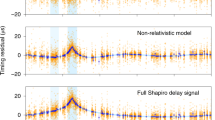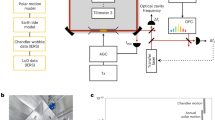Abstract
An attempt is made to understand the characteristics of pulsar slowdown in terms of various possible emission mechanisms. Though magnetic-dipole radiation seems to be dominant, the deviations from a pure dipolar decay are large compared with errors in measurement and indicate the presence of more complicated braking mechanisms, small fluctuations, and major “jumps”, or period discontinuities. Some rapid-relaxation effect is evident following the discontinuous jump in period in September 1969, but there is no evidence of the quasi-sinusoidal behaviour reported before the jump by Arecibo. An alternative interpretation of the Arecibo data is given.
This is a preview of subscription content, access via your institution
Access options
Subscribe to this journal
Receive 51 print issues and online access
$199.00 per year
only $3.90 per issue
Buy this article
- Purchase on Springer Link
- Instant access to full article PDF
Prices may be subject to local taxes which are calculated during checkout
Similar content being viewed by others
References
Cocke, W. J., Disney, M. J., and Taylor, D. J., Nature, 221, 525 (1969).
Radhakrishnan, V., and Manchester, R. N., Nature, 222, 228 (1969).
Reichley, P. E., and Downs, G. S., Nature, 222, 229 (1969).
Boynton, P. E., Groth, E. J., III, Partridge, R. B., and Wilkinson, D. T., IAU Circular, No. 2179.
Hoffman, B., Nature, 218, 667 (1968).
Counselman, C. C., III, and Shapiro, I. I., Science, 162, 352 (1968).
Papaliolios, C., Carleton, N. P., Horowitz, P., and Liller, W., Science, 160, 1104 (1968).
Boynton, P. E., Groth, E. J. III, Partridge, R. B., and Wilkinson, D. T., Ap. J. (Lett.), 157, L197 (1969).
Horowitz, P., Rec. Sci. Instrum., 40, 369 (1969).
Minkowski, R., Ap. J., 96, 199 (1942).
Baym, G., Pethick, C., Pines, D., and Ruderman, M., Nature, 224, 872 (1969).
Scargle, J. D., and Harlan, E. A., Ap. J. (Lett.), 159, 143 (1970).
Richards, D. W., Pettengill, G. H., Counselman, C. C., III, and Rankin, J. M., Ap. J. (Lett.), 160, L1 (1970).
Buckingham, R. A., Numerical Methods, 92 (Pitman, 1957).
Komesaroff, M. M., Nature, 225, 612 (1970).
Horowitz, P., thesis Harvard University (1970).
Author information
Authors and Affiliations
Rights and permissions
About this article
Cite this article
PAPALIOLIOS, C., CARLETON, N. & HOROWITZ, P. Absolute Time-of-arrival Measurements of Optical Pulses from the Crab Pulsar. Nature 228, 445–450 (1970). https://doi.org/10.1038/228445a0
Received:
Issue Date:
DOI: https://doi.org/10.1038/228445a0
This article is cited by
-
High-energy γ-ray light curve of PSR0531 + 21
Nature (1982)
-
Simulation of fulsar behavior in a low-temperature laboratory
Astrophysics (1980)
-
Magnetosphere of baryon stars. II. Inclined rotator
Astrophysics (1979)
-
Transient structure in the high-energy X-ray light curve of NP 0532
Nature (1977)
-
Cosmic rays from pulsars
Astrophysics (1975)
Comments
By submitting a comment you agree to abide by our Terms and Community Guidelines. If you find something abusive or that does not comply with our terms or guidelines please flag it as inappropriate.



